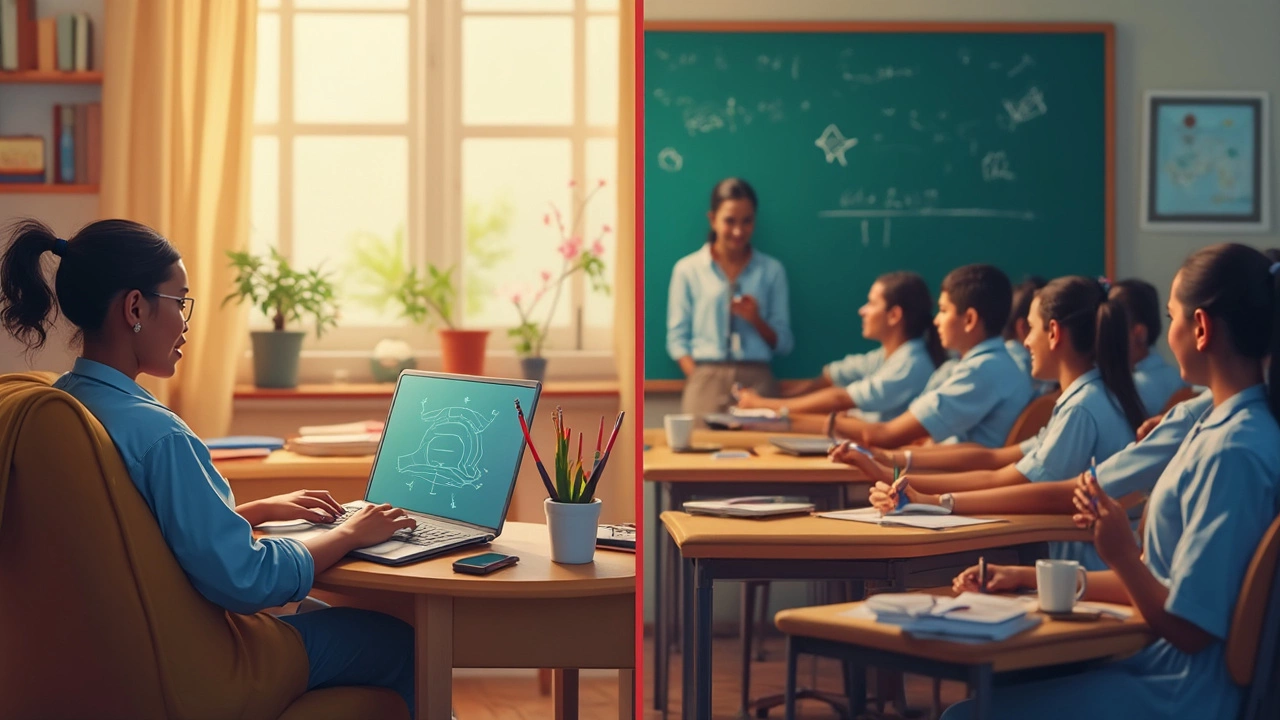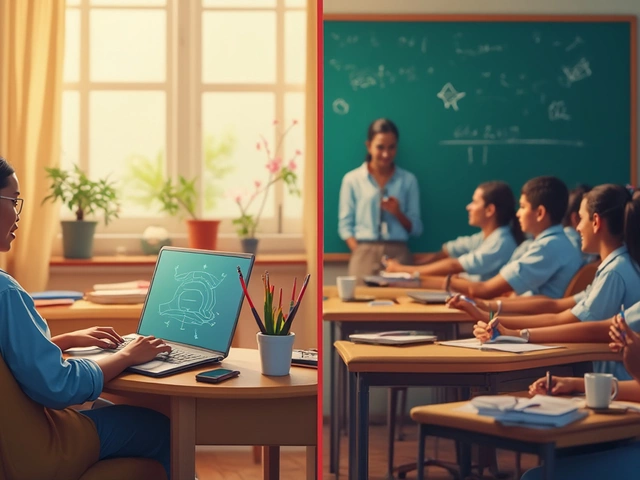Navigating the world of education today brings up an interesting choice—eLearning or classroom learning? Each has its own charm and challenges. So, what's really the difference?
Let's start with flexibility. eLearning often takes the cake here. You can study from a cozy corner at home or even in a café over a latte. It's perfect if you like setting your own pace. Classroom learning, on the other hand, offers structured schedules—ideal for those who thrive on routine.
And what about accessibility? Well, eLearning shines because anyone with an internet connection can access it. No need for a long commute or dealing with classroom capacity. But classroom learning offers hands-on experiences and immediate teacher interactions, which can be invaluable.
- Flexibility and Accessibility
- Learning Paces and Styles
- Technology and Tools
- Social Interaction and Engagement
- Cost Implications
- Effectiveness and Outcomes
Flexibility and Accessibility
One of the most noticeable perks of eLearning is its flexibility. Unlike traditional classroom learning, where you have to follow a set schedule, eLearning lets you pick and choose when you want to study. Got a busy day? No worries. You can hit the books—or the screen—when you're ready.
And let's not forget accessibility. Have an internet connection? Then you can dive into learning wherever you are. This is a game-changer, especially for folks who live miles away from educational institutions. No traveling hassles, no extra costs on commuting.
Life Adjustments
eLearning fits neatly into your lifestyle, cutting down commuting time and creating opportunities for learning during breaks at work or early mornings. You're in the driver's seat, picking the time and place that suits you best.
Availability of Resources
Everything you need is typically just a click away when you're learning online. Unlike the limitations of a physical library, eLearning platforms often provide access to a vast array of online resources—from textbooks to video lectures to interactive quizzes.
Classroom learning, in contrast, excels with immediate, face-to-face feedback. This can feel more interactive and personal for some students, which is something eLearning sometimes struggles to replicate.
| Feature | eLearning | Classroom Learning |
|---|---|---|
| Flexibility | High | Low |
| Accessibility | Global | Local |
Both methods have their own strengths, and the best choice often boils down to your personal needs and lifestyle. Think about what you're looking for in your educational journey and choose the path that suits you best!
Learning Paces and Styles
One of the biggest perks of eLearning is the ability to learn at your own pace. If you're someone who likes to take it slow and steady, you can revisit lessons multiple times until they fully click. In contrast, if you've got the hang of a topic quickly, you can zoom through without waiting for others to catch up.
Classroom learning, though structured, might not cater to individual pacing preferences as effectively. Everyone moves along at the same speed, and teachers often have to balance the needs of fast learners with those who might need a bit more time. It can be a challenge to meet everyone's learning styles in one setting.
Variety in Learning Styles
Now, let's talk about learning styles. eLearning platforms typically offer a wide array of content types—videos, quizzes, and interactive modules to name a few. This caters well to visual and auditory learners who might enjoy watching lecture videos or listening to podcasts. It's a playground for diverse learning preferences.
Classroom learning can also engage multiple senses but often depends on the teacher's style. Some teachers might incorporate hands-on activities, group discussions, and presentations, which can boost engagement for kinesthetic learners.
| Learning Style | eLearning Tools | Classroom Tools |
|---|---|---|
| Visual | Video lectures, animations | Blackboards, projectors |
| Auditory | Podcasts, voice recordings | Lectures, discussions |
| Kinesthetic | Interactive simulations | Lab experiments, group work |
Whatever your style is, knowing your preference can help in choosing the right learning environment. Remember, there's no one-size-fits-all when it comes to education, so exploring both options might just lead you to the perfect balance.
Technology and Tools
When it comes to eLearning, technology is your best friend. It's woven into every aspect, from video lectures to interactive quizzes. The big players like Zoom, Google Classroom, and Canvas have changed how we absorb knowledge. They're easy to use and constantly updated to bring in new features.
One cool thing about these digital platforms is that they often offer resources that cater to different learning styles. Visual learners can enjoy video content, while those who prefer reading can dive into PDFs and text-based materials. For interactive learners, options like quizzes and virtual breakout rooms keep things engaging.
Everyone's talking about Artificial Intelligence in this space. AI tutors and chatbots are becoming a common part of online education. They answer questions, provide feedback, and even adapt lessons to suit individual needs. As a Forbes article puts it,
"AI is not just improving the process of learning; it's revolutionizing it."
On the flip side, classroom learning relies less on cutting-edge tech. Sure, projectors, smartboards, and sometimes tablets play a part, but direct human interaction is the star. This environment is perfect for hands-on activities, be it science experiments or art projects, where technology takes a backseat.
One undeniable catch with technology in online education is that the tools require a decent internet connection and a device. Without these, participating might be tough. But for those equipped, the digital world offers a wider range of courses and materials accessible from anywhere.
Here's a quick comparison of some popular eLearning tools:
| Tool | Function |
|---|---|
| Zoom | Video conferencing for live classes |
| Google Classroom | Organizing learning materials and assignments |
| Canvas | Comprehensive course management |
In the end, the choice between these two learning methods often comes down to one's personal situation and preferences. But no denying, technology in education offers endless opportunities that a traditional classroom might not be able to match.

Social Interaction and Engagement
One of the biggest differences between classroom learning and eLearning is how students interact. In a classroom, you're surrounded by peers, which means spontaneous discussions and collaboration. Group projects make up a core part of this interaction, fostering teamwork and communication skills.
With eLearning, social engagement takes a different form. It's usually more formal and often requires effort to connect. Platforms like Zoom or Microsoft Teams allow for virtual classes and meetings, but you might miss the instant chemistry of face-to-face interactions. Yet, forums and chat groups on learning platforms provide spaces for questions and peer support.
Engagement through Technology
Technology in eLearning introduces unique engagement styles. Gamification, for example, encourages learners to participate actively. Things like quizzes with instant feedback or virtual classrooms with breakout rooms are popular.
But it's not just about connecting with peers. Interaction with instructors can be different, too. While in-person classes allow you to catch a teacher after class for queries, online platforms often have discussion boards or scheduled live Q&A sessions.
The Balance of Online Interaction
Creating a balance is crucial. A mix of synchronous (live) and asynchronous (self-paced) learning can help bridge the gap. This balance supports social needs without compromising the flexibility eLearning promises.
| Interaction Mode | Classroom | eLearning |
|---|---|---|
| Peer Interaction | Face-to-face, immediate | Virtual, planned or asynchronous |
| Instructor Availability | Direct access, after class chats | Scheduled online hours, email |
In the end, whether you're in a classroom or behind a screen, engaging with others helps enrich the learning experience. The choice often depends on whether you prefer the vibrancy of a classroom or the flexibility of online platforms.
Cost Implications
When choosing between eLearning and classroom learning, cost is a big factor. It's no secret that traditional education can come with hefty tuition fees, not to mention the extras like books, transport, and accommodation.
Upfront Costs
The biggest upfront cost in classroom learning is usually tuition. This doesn't account for things like classroom materials, lab fees, or trips. You're also likely to shell out for commuting or even relocating if the school is far from home.
In contrast, online education often boasts lower fees. Many platforms use digital resources—say goodbye to expensive textbooks. Brush off those commuting costs, too! Just make sure you have a reliable internet connection and a decent computer.
Hidden Costs
When considering hidden costs, classroom learning can sneak in extra charges for events, social activities, and equipment. It all adds up surprisingly fast.
Meanwhile, eLearning might demand some tech investment. Whether it's upgrading your gadgets or paying for faster internet, these are costs you want to factor in.
Long-term Value
Think about the long-term bang for your buck. Classroom settings might offer internships or networking opportunities that boost your career. But the flexibility of eLearning could let you earn while you learn, taking on part-time work alongside your studies.
Let's compare the average annual costs.
| Learning Type | Average Cost (Annual) |
|---|---|
| Classroom Learning | $10,000 - $50,000 |
| eLearning | $500 - $5,000 |
In the end, it boils down to personal preference and financial flexibility. Weigh your options and consider all factors—costs, but also the learning experience you value the most.
Effectiveness and Outcomes
When it comes to the effectiveness of eLearning versus classroom learning, it really depends on personal learning styles and the goals you're trying to achieve.
Measuring Learning Success
Recent data shows that students on online education platforms often perform just as well as their peers in traditional settings. One study from 2023 pointed out that students who adapt well to self-directed learning can actually excel in an eLearning environment. However, those who benefit from direct interaction with teachers might find greater success in classroom settings.
| Learning Environment | Average Improvement (%) |
|---|---|
| eLearning | 25% |
| Classroom Learning | 22% |
Skill Development
Both methods also shape skills differently. With eLearning, you often gain more technical skills just by navigating the platforms. Classroom learning, meanwhile, can offer more soft skill development like teamwork and communication.
Long-term Outcomes
Long-term, both types of learning provide valuable credentials. Employers today are increasingly recognizing online degrees and certifications, which reflects a shift in how the job market values online education. However, networking opportunities still tend to be stronger in traditional college settings.
In the end, whether eLearning or classroom learning is more effective hinges greatly on individual circumstances, preferences, and discipline. It’s fascinating how both these learning avenues have carved unique paths for learners across the globe.







